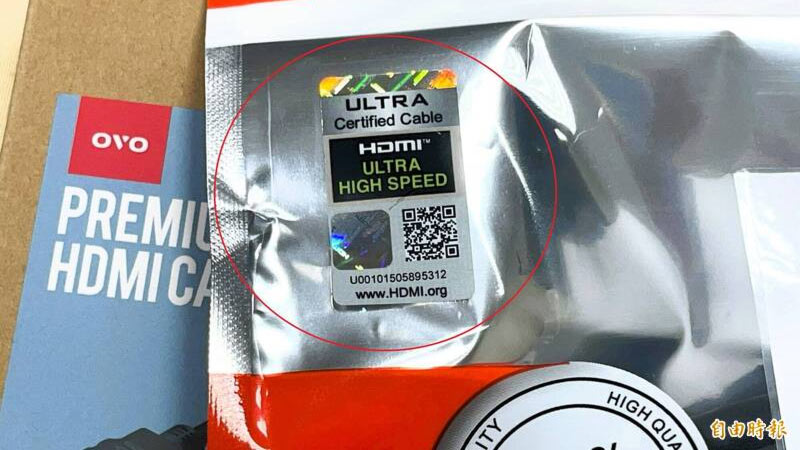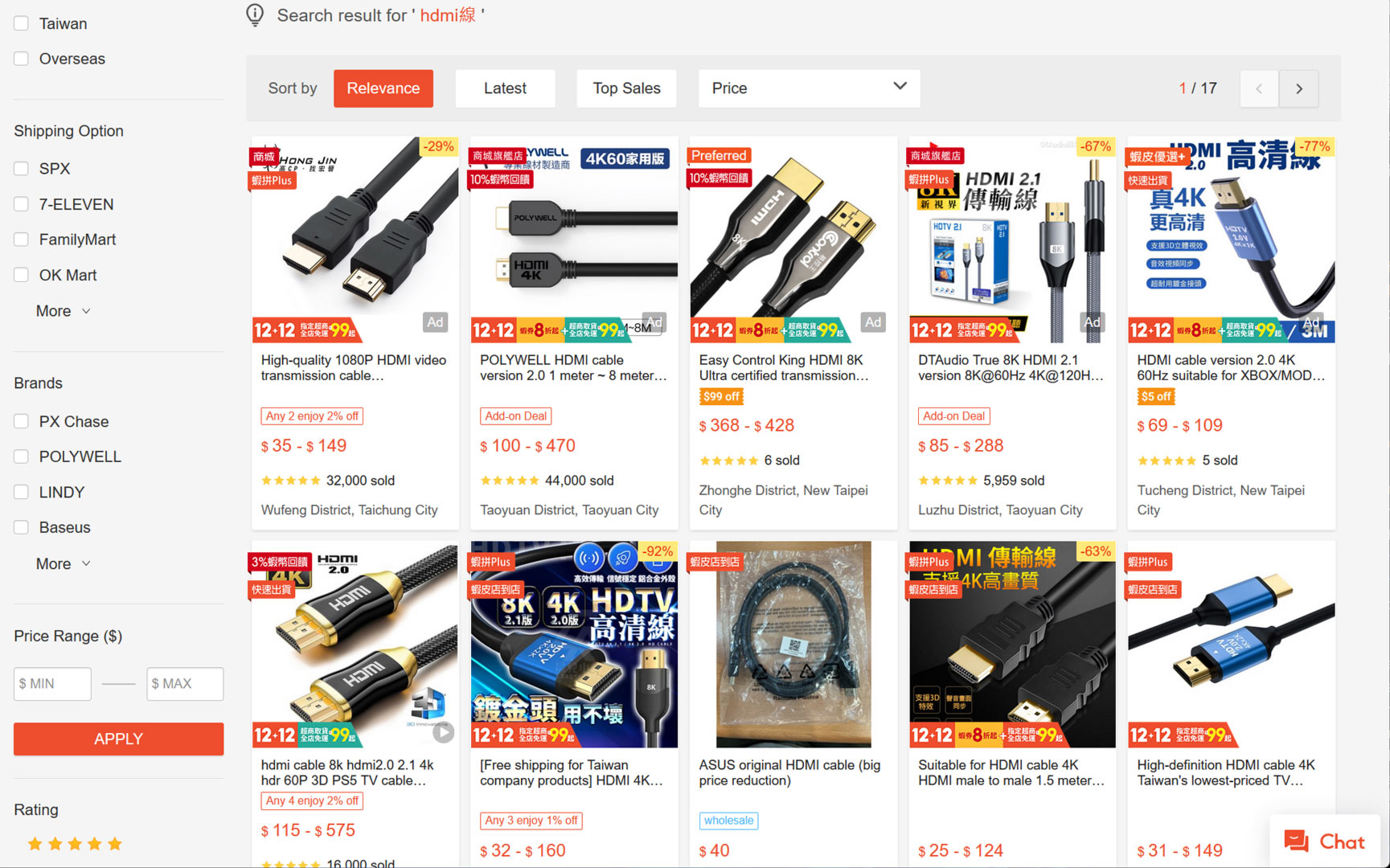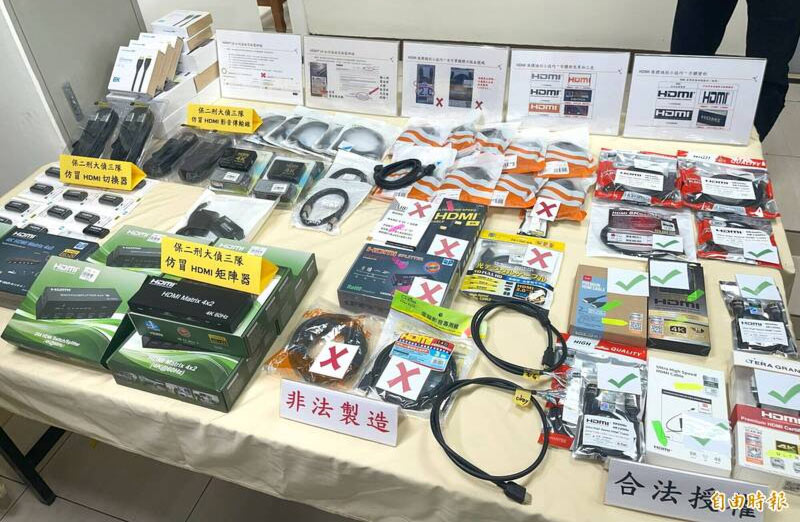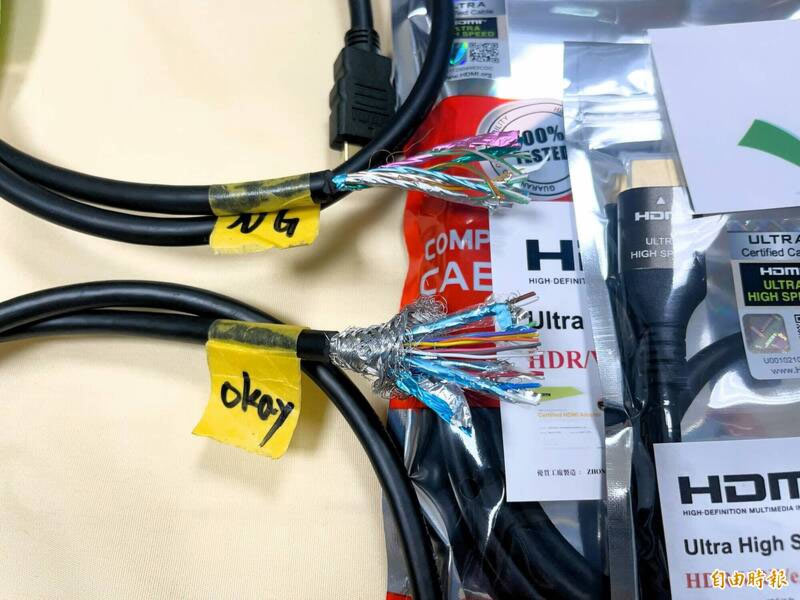Fake HDMI cable crackdown - Taiwanese police raid suppliers of counterfeit HDMI cables, seize $2.6 million in knockoffs in a single day
Police seized infringing goods valued at over TWD$80 million (USD$2.6 million) on Wednesday.

Counterfeit HDMI cables seem to be a big problem in high-tech Taiwan. Public service broadcaster PTS and the Liberty Times both published reports on Wednesday, sharing news of a police raid that netted 3,037 counterfeit HDMI cables from online sellers based in several major cities. According to reports, the seized goods had an “infringement market value” of over TWD$80 million (USD$2.6 million).
While the PTS reports characterize online sellers of counterfeit HDMI products as “unscrupulous operators,” the Police Department’s view seems to be less judgmental. For example, a police captain is quoted as saying that both the public and online sellers misunderstand HDMI. They typically think it is just the name of a connector or wire, and don’t know it is a registered trademark, reasoned the law enforcement official. However, products using the HDMI standard technology and / or trademark need to come from license fee-paying companies.
To try and raise awareness that HDMI isn’t just a cable name that can be used by anybody, the HDMI Association had a presence at Computex this summer, where a second-generation anti-counterfeiting certification label was launched. Customers are supposed to look for official labels, which integrate anti-counterfeiting measures such as patterns, holographic elements, and QR codes.
So, how big is the scale of the counterfeit HDMI cable problem in Taiwan? We've already mentioned that counterfeit HDMI goods were seized to an “infringement market value” of approximately USD$2.6 million in just one day this week. That seems a lot of money for 3,037 seized goods, and would indicate a value of USD$850 per item… We wonder if the sum includes licensing fines and / or damages. The Taiwanese reports also cite statistics that suggest that between 2022 and August 2023 counterfeit HDMI products worth nearly TWD$4 billion (USD$128 million) were sold on the island.
The HDMI Association will be filing lawsuits against the counterfeiters. However, the reports emphasize that police action should also protect consumers from cables that are of poor quality. It was warned that cables that have been manufactured without following HDMI standards and guidelines might not provide a good or consistent signals and might be poorly made. They might also have the potential to cause electrical fires.


In the meantime, we had a quick check through Shopee online marketplace listings in Taiwan and there still seems to be a plethora of suspicious HDMI cables for sale. For reference, NTD$100 is just USD$3.20.
Get Tom's Hardware's best news and in-depth reviews, straight to your inbox.

Mark Tyson is a news editor at Tom's Hardware. He enjoys covering the full breadth of PC tech; from business and semiconductor design to products approaching the edge of reason.
-
bit_user ...makes me wonder how many counterfeit HDMI cables have been sold in the US.Reply
I think counterfeits aren't necessarily inferior, although anyone too cheap to pay the HDMI licensing fee is probably too cheap not to take shortcuts in the cable design, construction, or materials.
If you want to be sure you're getting quality cables, I've found these guys to be reliable:
https://www.bluejeanscable.com/store/hdmi-cables/hdmi-cable.htm
To be honest, I've also bought plenty of cables off Newegg and Amazon, but I carefully check the claimed specs and the customer reviews. I look for cables with good review ratings, not just the cheapest. -
gggplaya Replybit_user said:...makes me wonder how many counterfeit HDMI cables have been sold in the US.
I think counterfeits aren't necessarily inferior, although anyone too cheap to pay the HDMI licensing fee is probably too cheap not to take shortcuts in the cable design, construction, or materials.
If you want to be sure you're getting quality cables, I've found these guys to be reliable:
https://www.bluejeanscable.com/store/hdmi-cables/hdmi-cable.htm
To be honest, I've also bought plenty of cables off Newegg and Amazon, but I carefully check the claimed specs and the customer reviews. I look for cables with good review ratings, not just the cheapest.
If all you need is standard 4k 24hz or 30hz video, then cheap cables work fine. But once you step up into HDR and true 120hz or higher refresh rates as well as VRR(Gsync/Freesync), you need good cables. I tried with what I though were 48gbps cables on amazon, it would cause my screen to flicker and go black periodically. Thank goodness for easy returns on Amazon.
I found that Zeskit hdmi cables on Amazon are a good budget option with true certification. At least they fixed my problems. -
Co BIY These sound more like unlicensed than counterfeit products and that seemed to be the police take as well.Reply
I've never had a cable problem and I pretty much buy the cheapest thing on amazon every time. I do go for something with a few decent reviews that seem real.
I am not doing anything that maxes out a spec though. -
bit_user Reply
Yeah, I try to buy higher-spec than I think I'll need - just to build in a little safety margin. Plus, I might someday actually need a cable of that spec and perhaps the extra margin won't have been necessary.Co BIY said:I am not doing anything that maxes out a spec though. -
ThomasKinsley That's why everyone should exclusively use Monster cables as they offer the best value for performance. :pReply -
gggplaya ReplyThomasKinsley said:That's why everyone should exclusively use Monster cables as they offer the best value for performance. :p
When I worked retail during college, they were always pushing us to sell Monster cables along with TV and related home theater products because the markups on those cables was insane. If I remember correctly, they were like 3x what we paid for them and the TV itself had very low margins when they are on sale. So we would make maybe 5-10% profit on a tv for $1000 which equates to about $50-$100, and about 300% profit on the cable for $75, so about $50, we could double the profit for that sale just by selling a Monster cable with it. -
bit_user Reply
I bought Monster Cables two times, before I learned better.ThomasKinsley said:That's why everyone should exclusively use Monster cables as they offer the best value for performance. :p
The first time was 1m RCA interconnect cables with connectors so tight they could rip the socket right out of your device. There was a twisting technique for getting them on and off, though it was complicated by the fact that the cables had a connector cover that was screwed on. So, you could only twist them one direction to avoid it unscrewing instead.
The second time was a pair of wires for my center channel speaker. When I moved, I noticed those cables had scorch marks and were a bit melted at the speaker end. The funny thing is I lived in an apartment with rather thin walls and so I kept the volume at the absolute minimum (and didn't use a subwoofer, either). Can't fathom how/why it melted, other than a really badly-made cable. To Monster's credit, they replaced it free-of-charge. The A/V receiver was made by Onkyo and not some cheap no-name brand, although this was like 20 years ago.
Anyway, the main reason I don't buy Monster is that they're just selling an image and not offering real value. For audio frequencies, you don't need a specially-designed cable. Speaker cables just need enough gauge. Interconnect cables can be shielded, but that's about it. Nothing else you can do to a cable makes a bit of difference to the sound.
I'll bet it was a similar story with extended warranties. I remember certain electronics retails used to make a very hard sell on the extended warranties.gggplaya said:we could double the profit for that sale just by selling a Monster cable with it. -
cyrusfox Display port for anything serious, HDMI for toys.Reply
The $856 fee per cable is puzzling though ($2600000/3037 cables recovered) -
bit_user Reply
DisplayPort is more computer-oriented, while HDMI is more home theater-oriented. That's just due to where they started life and the motives of the standards bodies behind them.cyrusfox said:Display port for anything serious, HDMI for toys.
If you're doing anything related to home theater, you'll tend to do a lot better with HDMI. For PCs, I agree that I prefer DisplayPort because it's simpler. Sadly, I've found monitors to have more HDMI inputs than DisplayPort, in spite of the fact that DisplayPort is royalty-free and HDMI isn't. -
gggplaya Replybit_user said:DisplayPort is more computer-oriented, while HDMI is more home theater-oriented. That's just due to where they started life and the motives of the standards bodies behind them.
If you're doing anything related to home theater, you'll tend to do a lot better with HDMI. For PCs, I agree that I prefer DisplayPort because it's simpler. Sadly, I've found monitors to have more HDMI inputs than DisplayPort, in spite of the fact that DisplayPort is royalty-free and HDMI isn't.
My problem is that many computer monitors are VRR(FreeSync) capable, but you need HDMI 2.1 ports for that. However they do not include a physical HDMI 2.1 port and only allow VRR with display port. You must read the fine spec print for your monitor and most mainstream consumers would never understand this. I had to help a couple friends with this, and simply told them to buy a display port cable. The problem is when they try to use a PS5 or Xbox X with the monitor, they can't do 120hz or VRR. They end up returning the monitor.
Most TV's that have true 120hz+ will have an HDMI 2.1 port.

